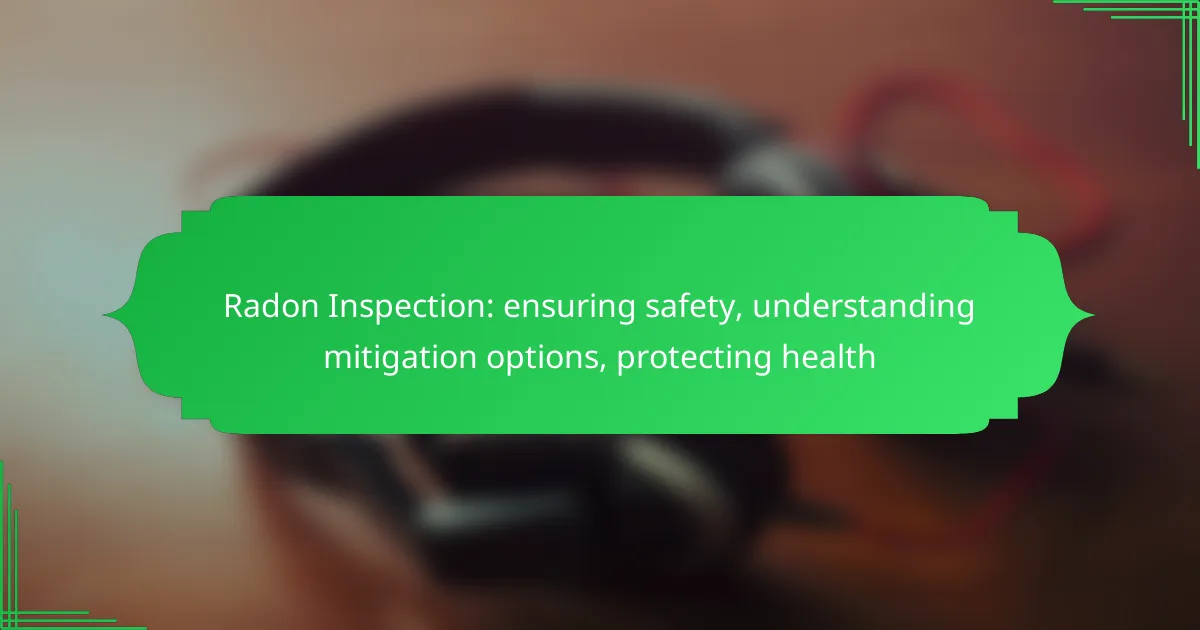Radon inspection is a crucial step in ensuring the safety of your home, as it measures the concentration of this colorless and odorless gas that can accumulate indoors. With certified services available, homeowners can access reliable testing and effective mitigation options to protect their health and reduce the risk of lung cancer associated with radon exposure.

What are the best radon inspection services in the United States?
The best radon inspection services in the United States provide reliable testing and mitigation options to ensure safety from radon exposure. These services are often certified and adhere to national standards, offering peace of mind for homeowners concerned about radon levels in their properties.
National Radon Proficiency Program
The National Radon Proficiency Program (NRPP) is a key organization that certifies radon measurement and mitigation professionals. This program ensures that service providers meet rigorous standards for testing and addressing radon levels, which is crucial for effective radon management.
Choosing a company certified by the NRPP can enhance your confidence in the quality of the radon inspection. Look for providers who display their NRPP certification prominently, as this indicates adherence to best practices in the industry.
Radon Environmental Management Corp
Radon Environmental Management Corp specializes in comprehensive radon testing and mitigation solutions across the United States. They offer both short-term and long-term testing options, allowing homeowners to choose the best fit for their needs.
In addition to testing, they provide detailed reports and recommendations for mitigation if elevated radon levels are detected. Their experienced technicians are trained to implement effective radon reduction systems, ensuring a safer living environment.
Radon Mitigation Services
Radon Mitigation Services focuses on reducing radon levels in homes and commercial buildings. They utilize various techniques, such as sub-slab depressurization and ventilation systems, to effectively lower radon concentrations.
When selecting a mitigation service, consider their track record and customer reviews. A reputable service will provide a clear plan and warranty for their work, ensuring long-term safety and compliance with local regulations.
Air Chek
Air Chek offers radon testing kits that are user-friendly and reliable. Their kits can be used for both short-term and long-term testing, making them suitable for different homeowner needs and preferences.
They also provide detailed instructions and support for interpreting results, which can help homeowners make informed decisions about necessary actions if radon levels are elevated.
Radon Testing Services
Radon Testing Services provide professional testing options that include both passive and active measurement techniques. These services often employ certified technicians who can ensure accurate results and compliance with national standards.
When considering radon testing, it’s advisable to schedule tests during the colder months when homes are sealed, as this typically yields the most accurate readings. Always verify that the service provider uses NRPP-certified methods for reliable results.
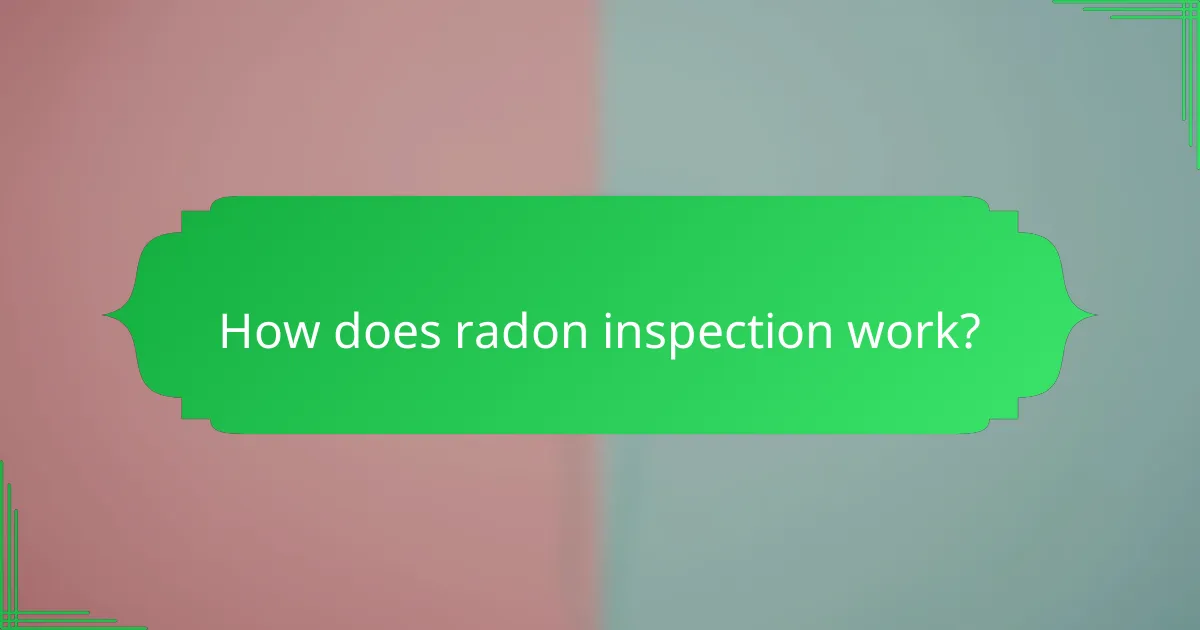
How does radon inspection work?
Radon inspection involves measuring the concentration of radon gas in a building to assess potential health risks. This process typically uses specialized testing kits or devices that detect radon levels over a specified period.
Short-term testing methods
Short-term testing methods provide quick results, usually within two to seven days. These tests can be conducted using devices such as charcoal canisters or electronic monitors placed in the lowest livable area of the home.
While short-term tests are convenient, they can be influenced by factors like weather and ventilation. It’s advisable to conduct these tests during closed-house conditions—keeping windows and doors closed for at least 12 hours before testing.
Long-term testing methods
Long-term testing methods measure radon levels over a period of 90 days to one year, offering a more accurate representation of average radon exposure. Devices used for long-term testing include alpha track detectors and continuous radon monitors.
These methods are less susceptible to short-term fluctuations and provide a clearer picture of radon levels in your home. For best results, place the testing device in a frequently used room, away from drafts and direct sunlight, to ensure reliable readings.
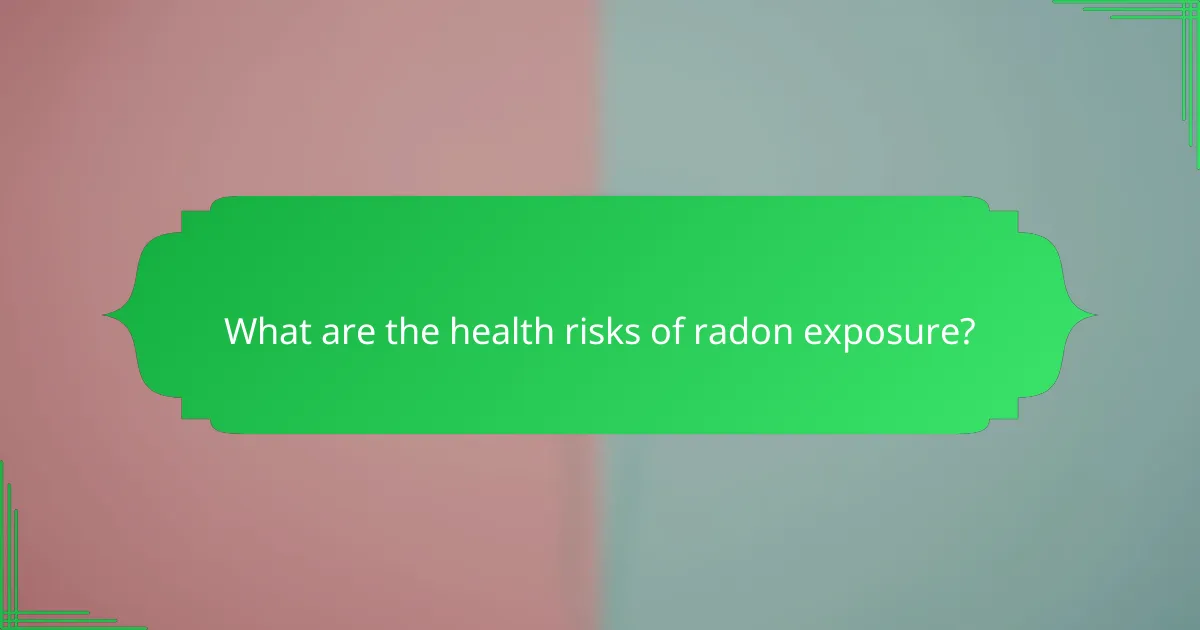
What are the health risks of radon exposure?
Radon exposure poses significant health risks, primarily increasing the likelihood of lung cancer. It is a colorless, odorless gas that can accumulate in homes, particularly in basements and poorly ventilated areas.
Lung cancer risk
Radon is the second leading cause of lung cancer after smoking, contributing to thousands of cases annually. The risk of developing lung cancer from radon exposure increases with higher levels of radon and longer exposure times.
For instance, the U.S. Environmental Protection Agency (EPA) suggests that homes with radon levels above 4 picocuries per liter (pCi/L) should be mitigated. The risk is particularly high for smokers, as the combination of smoking and radon exposure significantly elevates lung cancer risk.
Symptoms of radon exposure
Radon exposure typically does not cause immediate symptoms, making it particularly dangerous. Long-term exposure can lead to serious health issues, including persistent cough, wheezing, and shortness of breath.
Since symptoms often resemble those of other respiratory conditions, it is crucial to test for radon rather than rely on symptoms alone. Regular testing can help identify elevated radon levels, allowing for timely mitigation to protect health.
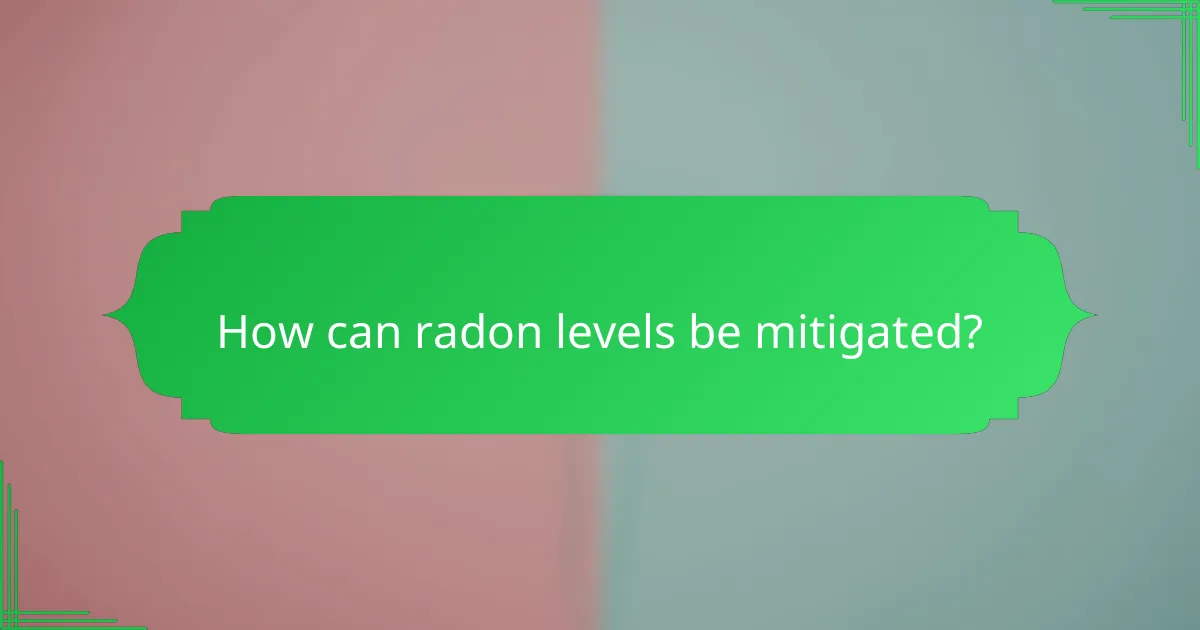
How can radon levels be mitigated?
Radon levels can be effectively mitigated through several methods that reduce radon entry into homes and buildings. These techniques focus on improving ventilation, sealing entry points, and actively managing soil pressure to keep radon gas at safe levels.
Active soil depressurization
Active soil depressurization involves installing a system that reduces the pressure in the soil beneath a building, preventing radon from entering. This typically includes a fan that draws air from beneath the foundation and vents it outside, effectively lowering the radon concentration indoors.
When considering this method, ensure that the system is properly designed and installed by a qualified professional. Regular maintenance is essential to keep the fan operational and the system effective.
Ventilation systems
Ventilation systems can help dilute radon levels by increasing the airflow within a building. This can be achieved through mechanical ventilation, such as heat recovery ventilators (HRVs) or energy recovery ventilators (ERVs), which bring in fresh air while exhausting stale air.
For optimal results, ensure that the ventilation system is balanced and capable of handling the specific air exchange needs of your space. Regularly check filters and ducts to maintain efficiency and air quality.
Sealing cracks and openings
Sealing cracks and openings in walls, floors, and around pipes can significantly reduce radon entry points. Common materials used for sealing include caulk, expanding foam, and concrete sealants, which can effectively block pathways for radon gas.
Inspect your home for visible cracks and gaps, especially in the foundation and basement areas. Regular maintenance and re-sealing as needed can help maintain lower radon levels over time.
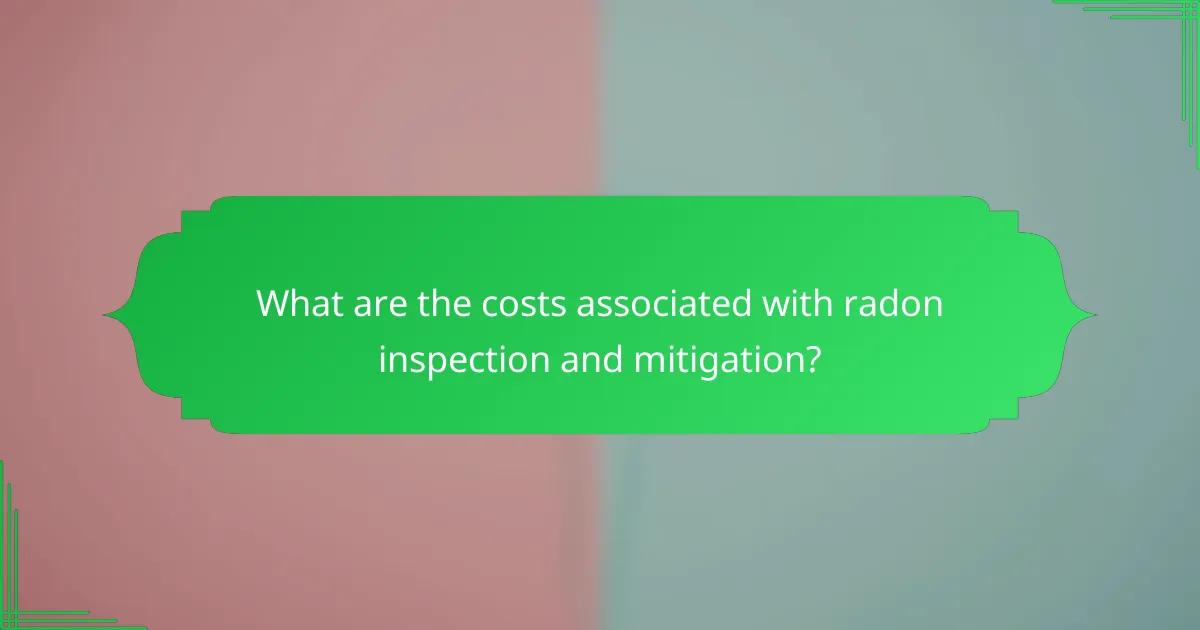
What are the costs associated with radon inspection and mitigation?
The costs for radon inspection and mitigation can vary significantly based on factors such as location, property size, and the complexity of the mitigation system needed. Generally, homeowners can expect to spend a few hundred to over a thousand dollars for inspection and mitigation services.
Average inspection costs
Radon inspection costs typically range from $100 to $300, depending on the type of test used and the size of the home. Short-term tests, which last a few days, are generally less expensive than long-term tests that can take several months to provide accurate readings.
It’s advisable to hire a certified radon inspector to ensure the testing meets local regulations and standards. Some states may have specific requirements for radon testing, which can influence the overall cost.
Mitigation system installation costs
The installation of a radon mitigation system usually costs between $800 and $2,500, depending on the home’s design and the chosen method of mitigation. Active systems, which use fans to vent radon outside, tend to be more expensive but are often more effective than passive systems.
Homeowners should consider the long-term benefits of mitigation, as reducing radon levels can significantly lower health risks. It’s important to obtain multiple quotes from qualified contractors to ensure competitive pricing and quality service.
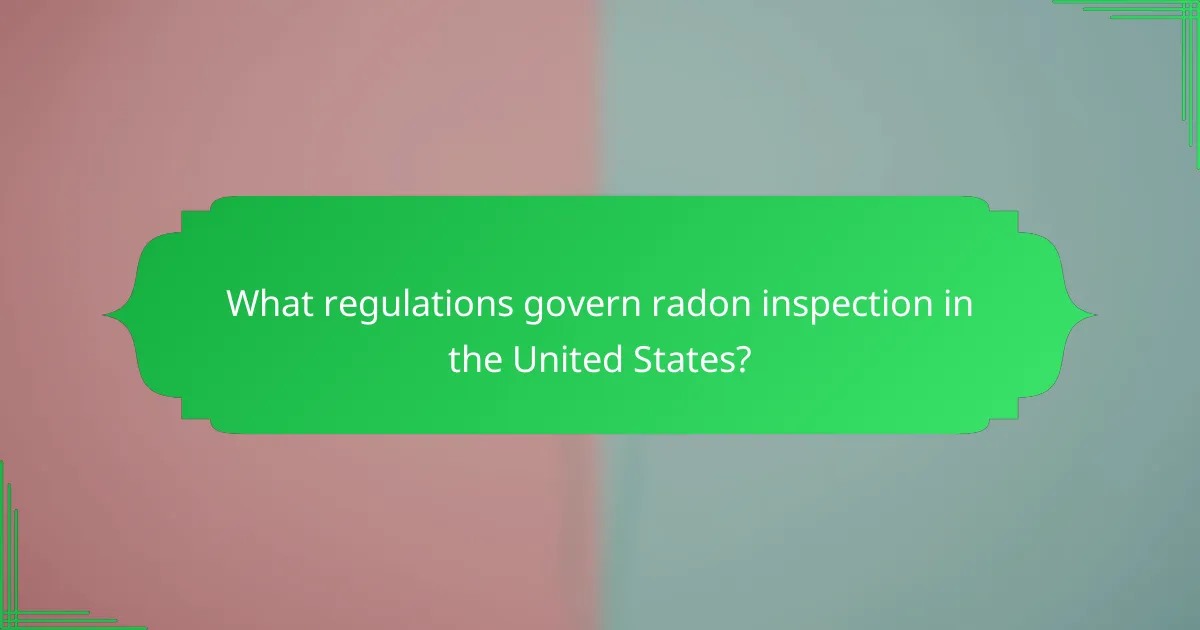
What regulations govern radon inspection in the United States?
Radon inspection in the United States is primarily governed by guidelines set forth by the Environmental Protection Agency (EPA) and various state-specific regulations. These regulations aim to ensure safe radon levels in homes and buildings, protecting public health from the risks associated with radon exposure.
Environmental Protection Agency guidelines
The EPA provides comprehensive guidelines for radon testing and mitigation, recommending that homes be tested for radon levels, especially in areas known for high radon potential. The agency suggests using a certified radon measurement professional and following specific protocols for accurate results.
According to EPA standards, radon levels above 4 picocuries per liter (pCi/L) warrant action to reduce exposure. Homeowners are encouraged to conduct follow-up testing after mitigation to ensure that radon levels remain below this threshold.
State-specific regulations
In addition to federal guidelines, many states have their own regulations regarding radon inspection and mitigation. These regulations can vary significantly, with some states requiring radon testing during real estate transactions or mandating the use of licensed professionals for mitigation work.
Homeowners should check their state’s specific requirements, as some states offer radon testing kits at low or no cost and may have programs to assist with mitigation costs. Understanding local regulations can help ensure compliance and enhance safety measures in homes.
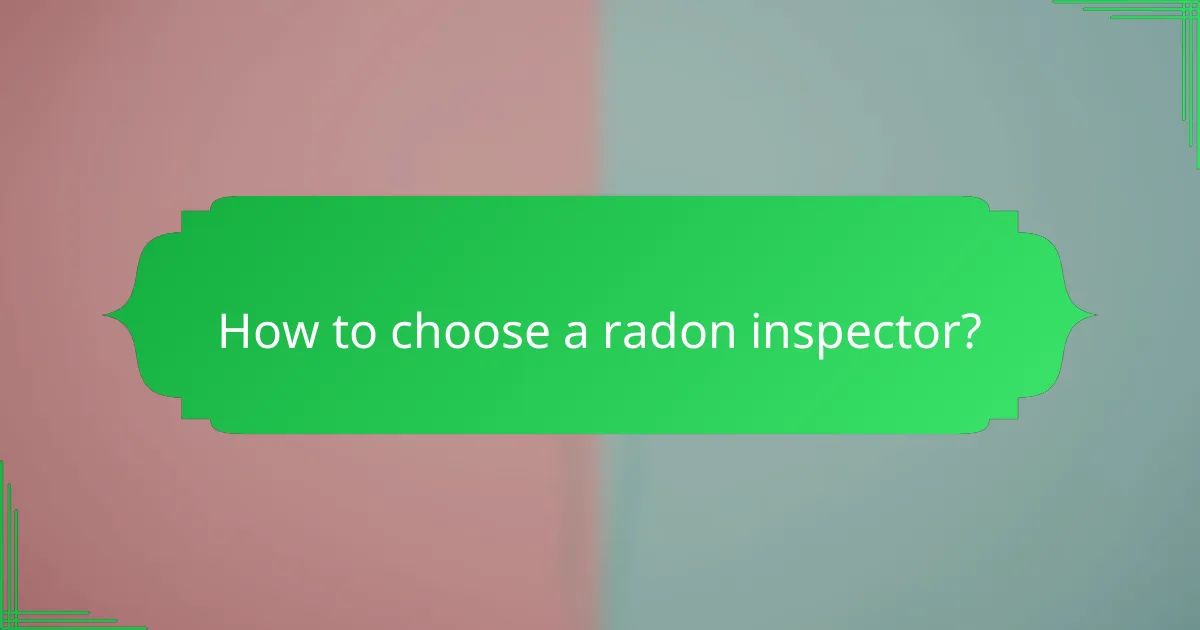
How to choose a radon inspector?
Selecting a qualified radon inspector is crucial for ensuring accurate testing and effective mitigation. Look for inspectors who are certified, experienced, and knowledgeable about local regulations and radon levels.
Qualifications to look for
When choosing a radon inspector, prioritize those with certification from recognized organizations, such as the National Radon Proficiency Program (NRPP) or the National Radon Safety Board (NRSB). These certifications indicate that the inspector has undergone proper training and adheres to industry standards.
Experience is another key factor; inspectors with several years in the field are likely to have encountered a variety of situations and can provide valuable insights. Additionally, check for any reviews or testimonials from previous clients to gauge their reliability and professionalism.
Testing methods used
Radon inspectors typically use two main testing methods: short-term and long-term testing. Short-term tests, which last from two to seven days, provide quick results but may not reflect seasonal variations. Long-term tests, lasting over 90 days, offer a more accurate picture of radon levels in your home.
Ask the inspector about the specific devices they use, such as alpha track detectors or continuous radon monitors, as these can impact the accuracy and reliability of the results. Ensure that the testing method aligns with your needs and local guidelines.
Cost considerations
The cost of hiring a radon inspector can vary widely, typically ranging from $100 to $300 for a standard test. Factors influencing the price include the inspector’s experience, the testing method chosen, and the size of your home.
While it may be tempting to choose the cheapest option, consider the value of thoroughness and expertise. Investing in a qualified inspector can save you money in the long run by ensuring proper mitigation if high radon levels are detected.
Post-inspection follow-up
After the inspection, the inspector should provide a detailed report outlining the radon levels detected and any recommended actions. If elevated levels are found, discuss mitigation options, such as installing a radon reduction system, to protect your health.
Ensure that the inspector is available for follow-up questions and can guide you through the mitigation process. A good inspector will not only test your home but also help you understand the results and next steps.
